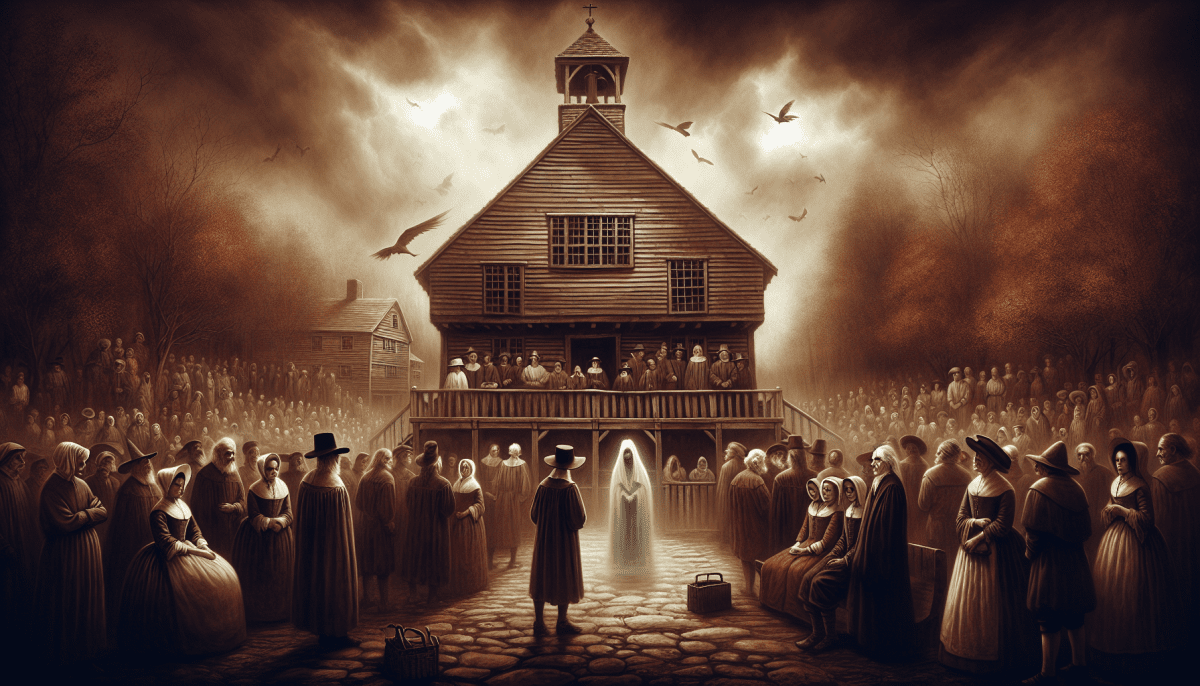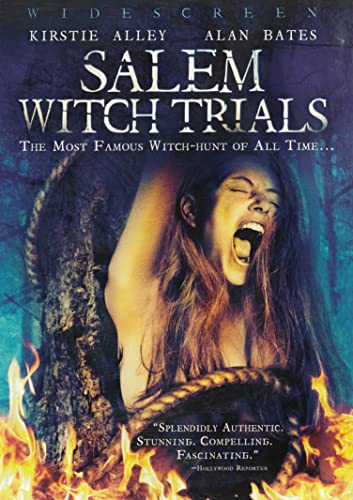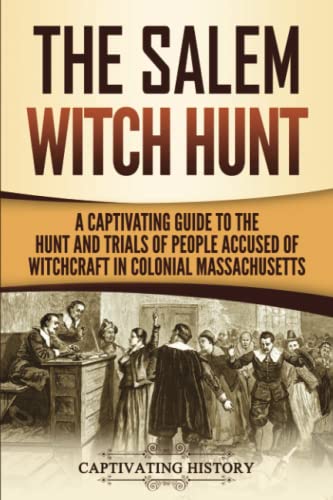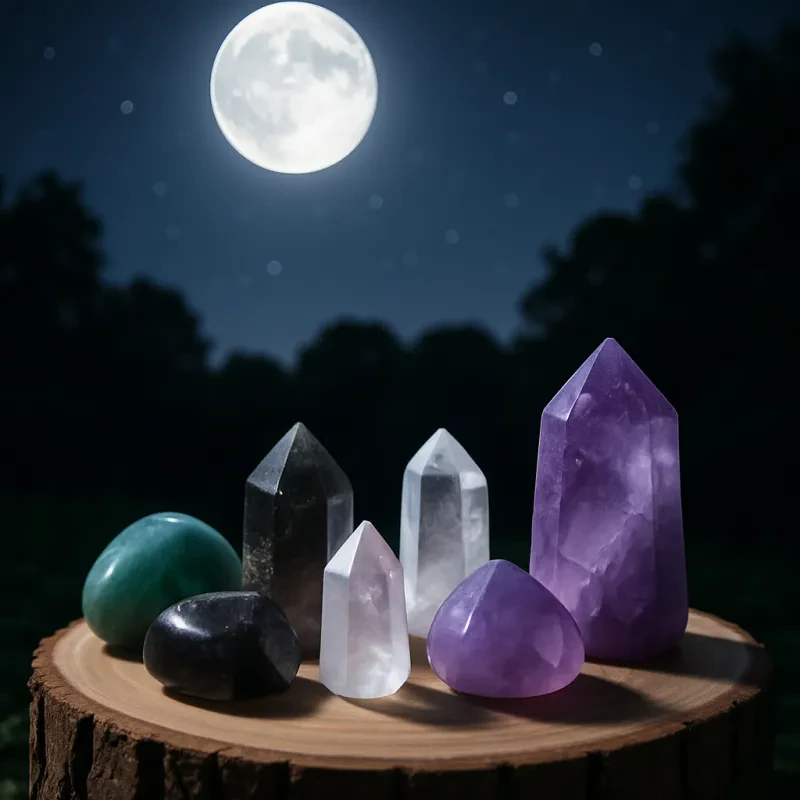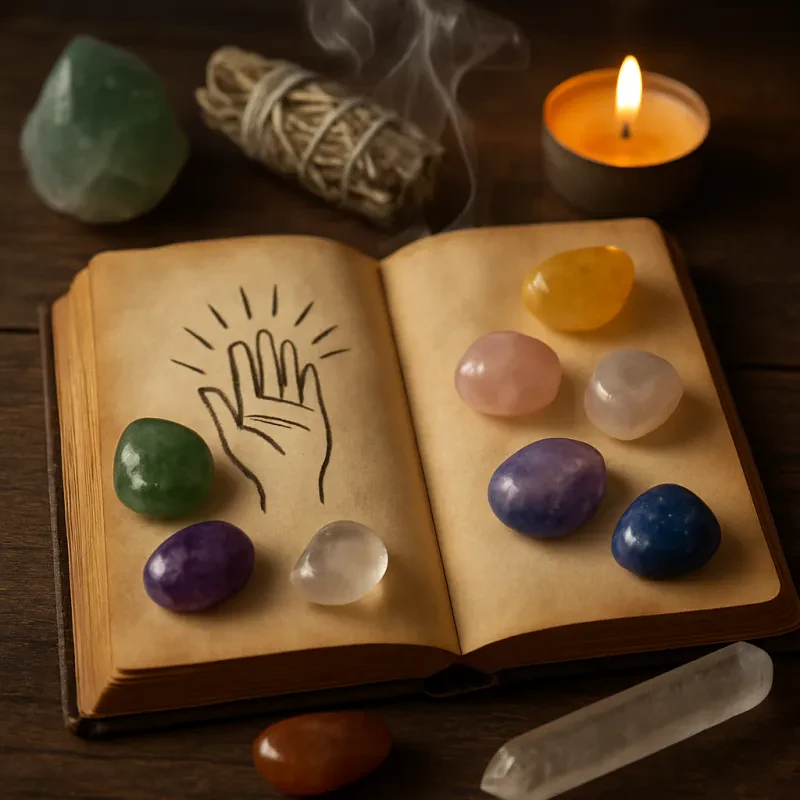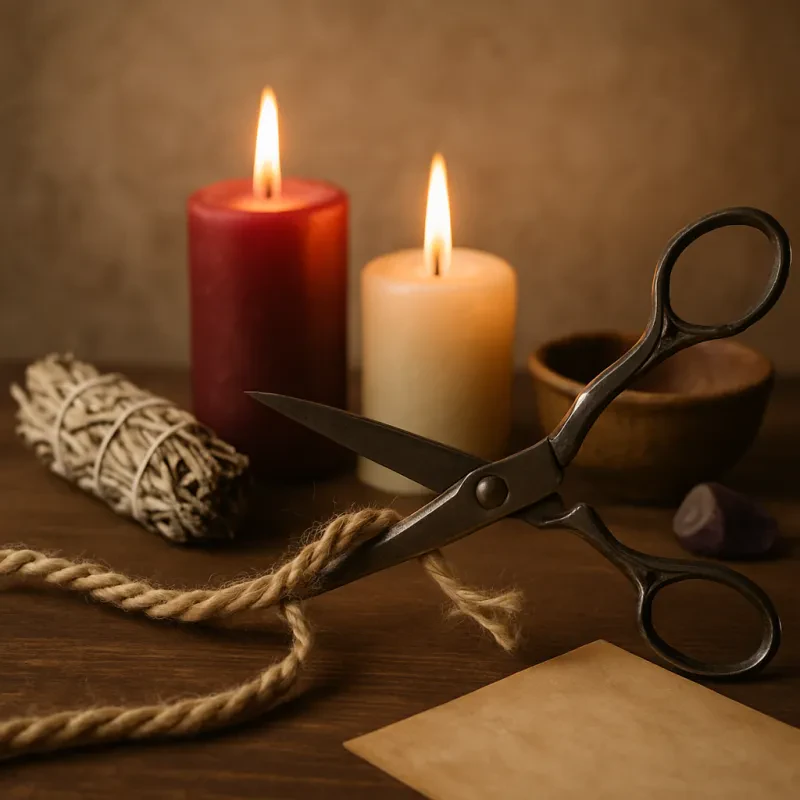Salem Witchcraft: The Truth Behind the History
In 1692, the town of Salem, Massachusetts, became the focal point of a series of events that would leave an indelible mark on American history and culture. The Salem witch trials, a period marred by fear, hysteria, and the pursuit of justice gone awry, led to the prosecution of numerous individuals for witchcraft. This dark chapter for Salem Witches was set in motion by a group of young girls who claimed to be possessed by the devil, triggering widespread panic and the establishment of a special court in Salem to adjudicate these cases [1][2]. Among those ensnared in the trials were Bridget Bishop, the first convicted witch who was hanged in June 1692, and a total of 25 victims, including women, men, and children, who paid with their lives, mostly through execution by hanging [2][3].
The Salem witch trials serve as a sobering reminder of the potent dangers of mass hysteria, the critical importance of due process, and the harrowing potential for miscarriages of justice. The Salem witches phenomenon, woven deeply into the fabric of societal fears and superstitions of the time, underscores the tragic outcomes when legal and moral boundaries are transgressed. As we delve into the historical context, key figures, legal procedures, and the aftermath of these events, we shall also touch upon the legacy of the victims of the Salem Witch trials, like Bridget Bishop, whose stories serve as poignant lessons in the annals of American history. Their narratives, interconnected with the legacy of the Salem witch trials, offer a compelling examination of human nature, justice, and collective memory [2][3][4].
Historical Context
Legal and Social Framework
- Colonial Legal Foundations: The legal backdrop of the Salem witch trials was shaped significantly by the Massachusetts Bay Colony statute from 1641, rooted in biblical passages and reinforced by the Witchcraft Act of 1604, which declared witchcraft as a felony [1][5].
- The Body of Liberties: Drafted in 1641 by the General Court of the Massachusetts Bay Colony, this document was a pivotal collection of civil and criminal laws that influenced the legal proceedings of the Salem witch trials [5].
- Precedents and Practices: Historically, executions for witchcraft were rare in the region before the infamous Salem witch trials of 1692, highlighting the unusual severity and hysteria of the trials [5].
Socio-Political Climate
- A Time of Uncertainty: The trials unfolded during a period of intense stress within the Massachusetts Bay Colony, exacerbated by factors such as a recent smallpox epidemic, ongoing threats from warring tribes, and prevailing superstitions about the devil [6].
- Geographical and Social Divides: The distinction between Salem Town, a bustling port, and Salem Village, a poorer farming community, illustrates the socio-economic tensions that may have fueled the witchcraft accusations [4].
- Wider Witchcraft Craze: The Salem events were part of a broader European witch hunt narrative that spanned from the 14th to the late 18th century, suggesting a transatlantic fear of witchcraft that culminated in numerous trials and executions [4].
Key Figures and Initial Accusations
- The Afflicted and the Accused: The crisis began when young girls in Salem Village, including the daughter and niece of Reverend Samuel Parris, exhibited mysterious fits attributed to supernatural forces, leading to the first accusations against Tituba, Sarah Good, and Sarah Osborne [7][8].
- Community and Conflict: The initial targets of accusations were individuals of marginal social status; however, as the hysteria grew, more prominent community members were also implicated, reflecting the deep-seated social conflicts within the village [8].
- Culmination and Resolution: The trials escalated rapidly, with over 200 accusations and 25 deaths, before concluding in 1693 when all accused were pardoned, marking a somber end to a dark chapter in colonial American history [3][8].
Key Figures of the Trials
Accusers and the Accused
- The Circle of Young Accusers: Central to the trials were the accusers, primarily young girls like Betty Parris and Abigail Williams, aged between 9 and 19. These girls held unusual influence in a patriarchal society, their accusations leading to the initial trials [1][11].
- Tituba, Sarah Good, and Sarah Osborne: The first to be accused and hence, the most famous Salem Witches were Tituba, an enslaved woman from Barbados, along with Sarah Good and Sarah Osborne. Tituba's confession under duress played a significant role in legitimizing the accusations that spiraled out of control [7][8][3].
Notable Victims
- Bridget Bishop: Known for her assertive demeanor and non-conformity to Puritan norms, Bridget Bishop was the first person executed during the trials on June 10, 1692. She had faced accusations of witchcraft before, highlighting a community predisposed to suspicion and conflict [14].
- Reverend George Burroughs: The only Puritan minister executed, Burroughs was hanged on August 19, 1692. His indictment was particularly shocking as it targeted a religious leader, illustrating the trials' reach and severity [14].
- Giles Corey: Accused of witchcraft in April 1692, Corey's refusal to stand trial led to his death by peine forte et dure, a form of torture where he was crushed under heavy stones, marking a gruesome episode of the trials [14].
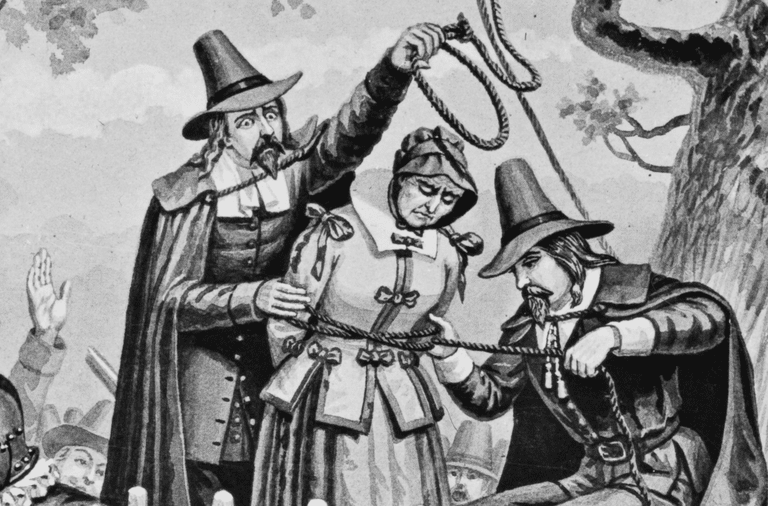
Responses and Confessions
- Tituba's Confession: Under immense pressure, Tituba confessed to being a witch, accusing others and setting a precedent for further confessions. Her pivotal role is underscored by her eventual release from prison in 1693 after the hysteria subsided [3].
- Community Accusations: The trials were marked by accusations from neighbors and even family members against one another, reflecting deep-seated fears and tensions within the Salem community [14].
Legal Procedures and Evidence
Types of Evidence and Legal Standards
- Confession and Eyewitness Testimony: The courts during the Salem witch trials primarily relied on confessions and the testimony of two eyewitnesses to acts of witchcraft as the standard forms of evidence [1].
- Spectral Evidence: This controversial form of evidence included the testimony of the afflicted, who claimed to interact with the apparitions of those tormenting them. Such evidence, which played a critical role in the trials, was later deemed inadmissible by the Superior Court of Judicature [1].
Court Structure and Legal Practices
- Court of Oyer and Terminer: Initially, this court handled the witchcraft cases, operating under the presumption of guilt, which significantly deviated from modern judicial principles [15].
- Superior Court of Judicature: Established after the dissolution of the earlier court, this court marked a pivotal shift by disallowing spectral evidence, which was a step towards more rational legal procedures [1][5].
Legal Failures and Their Impact on Modern Law
- Lack of Legal Protections: The absence of rights such as legal representation and the hearsay rule allowed for the use of rumors and weak testimonies in trials, leading to numerous wrongful convictions [15].
- Reforms Post-Trials: The egregious errors and judicial failures observed during the Salem witch trials prompted significant legal reforms, including the right to legal representation and the presumption of innocence in the U.S. legal system [4].
Consequences and Aftermath
Legislative Reforms and Restitutions
- Legal Reforms: The Salem witch trials exposed critical flaws in the legal system, leading to significant changes in court procedures. These reforms included the establishment of rights to legal representation, the ability to cross-examine accusers, and the presumption of innocence, which are fundamental aspects of the modern U.S. judicial system [17].
- Exoneration and Restitution: In 1711, Massachusetts formally exonerated those who were executed and provided restitution to their families. This act acknowledged the grave injustices done and aimed to ameliorate the suffering of the families affected by the trials [15][18].
Societal Impact and Historical Lessons
- Metaphor for Injustice: The trials have become a powerful metaphor for the dangers of mass hysteria and the abuse of power, often compared to other historical events such as the McCarthy hearings during the 1950s Red Scare [4][17].
- Cautionary Tale: The Salem witch trials serve as a historical lesson on the perils of false accusations and societal panic, emphasizing the importance of due process and rational legal procedures [4][17].
Influence on American Constitutional Development
- Bill of Rights Inspiration: The injustices of the Salem witch trials influenced the development of the U.S. Bill of Rights, emphasizing the need to protect individual freedoms against arbitrary and unfounded accusations [15].
- Reflection on Human Rights: The trials underscored the potential for governmental overreach and highlighted the critical need for safeguards to protect civil liberties [15].
The Trials' Legacy and Cultural Impact
Cultural Resonance in Media and Literature
The Salem witch trials have profoundly influenced both historical narratives and pop culture, serving as a cautionary tale of injustice and mass hysteria. The trials have been depicted in various media forms, highlighting their enduring appeal and relevance. For instance, Arthur Miller's play "The Crucible," written during the 1950s, uses the trials as an allegory for McCarthyism, reflecting on themes of persecution and fear [10][19]. This play, along with other portrayals such as in television shows and movies like Bewitched and Hocus Pocus, underscores the trials' significant cultural impact, often focusing on themes of intolerance and injustice [10].
Legal and Educational Repercussions 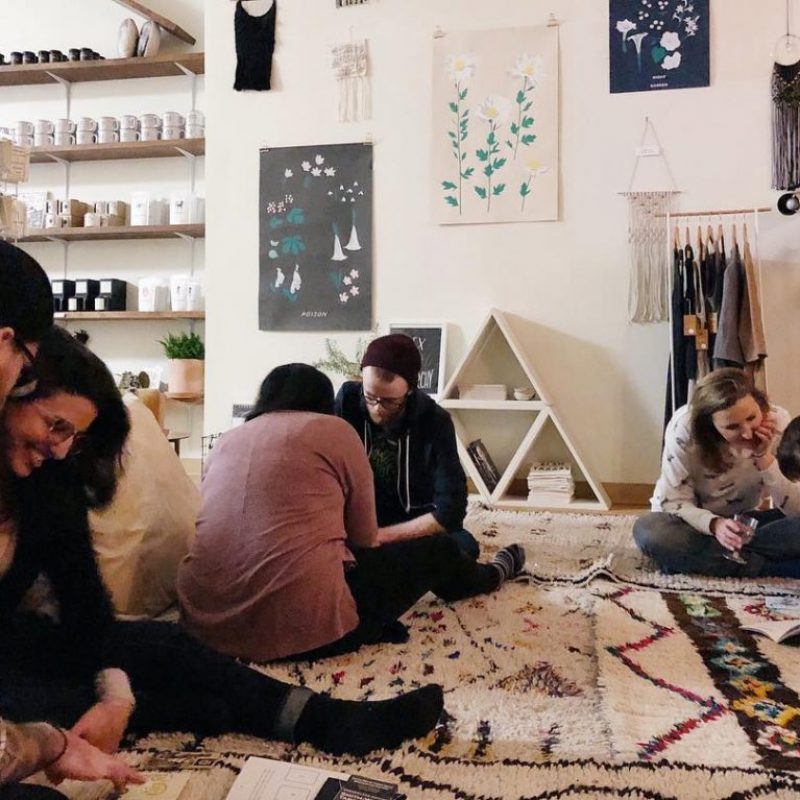
The Salem witch trials' legacy extends into legal education and the framing of rights within the U.S. Constitution. The trials underscored the critical need for legal protections, influencing the inclusion of a Bill of Rights to safeguard against unjust governmental actions [15]. This historical event has become a staple in educational curriculums, often used to teach about the dangers of flawed legal systems and the importance of due process [15][21].
Modern Witchcraft and Social Justice
In contemporary Salem, the memory of the trials continues to shape local identity and practices. Salem's modern witch community, distinct from the historical accusations of witchcraft, promotes values of acceptance and social justice [10]. This community actively works to dissociate from the negative stereotypes often associated with witches, focusing instead on peaceful, Pagan traditions [10]. The transformation of the witch's image from one of fear to a symbol of empowerment reflects a broader societal shift towards inclusivity and understanding of alternative religious practices [10][21].
Contemporary Relevance
Legal and Social Lessons from Salem
The Salem witch trials underscore the critical need for legal protections that are now considered fundamental in modern legal systems. The lack of basic legal safeguards such as the presumption of innocence led to tragic consequences, which have been instrumental in shaping contemporary views on justice and legal fairness [15]. These historical events serve as a cautionary tale, emphasizing the importance of due process to protect individuals against false accusations and highlighting the dangers when legal systems fail to do so [9][19].
Persistent Beliefs and Modern Witch Hunts
Despite advances in science and education, beliefs in witchcraft persist globally, influencing social dynamics and sometimes leading to violent outcomes. Surveys indicate that a significant portion of the population in countries like Canada, the UK, and the USA still believe in witches [22]. In regions with limited access to education and healthcare, witch hunts not only persist but can result in severe violence or even death, as seen in countries like India, Nigeria, and Papua New Guinea [22]. This ongoing issue reflects the continued relevance of the Salem events as examples of how fear and ignorance can lead to social persecution.
Influence on Constitutional Rights
The Salem witch trials had a profound impact on the development of legal frameworks in the United States, particularly the inclusion of the Bill of Rights in the U.S. Constitution. These amendments were directly influenced by the injustices observed during the trials, highlighting the necessity of protecting citizens against unfounded governmental accusations and the abuse of power [15]. The First Amendment's stance on slander and defamation further underscores the trials' lasting influence on American legal principles, ensuring protections that prevent the recurrence of similar miscarriages of justice [19].
FAQs
- What led to the Salem Massachusetts witch trials?
The Salem witch trials began in the 17th century when witchcraft was defined as a pact with the devil against Christianity. In 1692, several young girls in Salem Village claimed they were tormented by invisible forces and accused local residents of witchcraft. - Why are the Salem witch trials considered mysterious?
The trials are noted for their mysterious nature due to the reliance on unsubstantiated accusations and the acceptance of spectral evidence, such as dreams and visions, as legitimate proof. This resulted in numerous wrongful convictions due to the flawed legal procedures of the time. - What was the prevailing belief about witchcraft in Salem?
The Puritans held the view that Satan could not impersonate any person without their consent. Consequently, if someone witnessed a ghost or spirit resembling someone else, it was believed that the person whose form was taken must be in league with the devil, thereby labeling them a witch. - What factors triggered the Salem witch trials?
The outbreak of witchcraft accusations in Salem can be attributed to a mix of church politics, existing family feuds, and the erratic behavior of some children. These elements combined in a setting devoid of stable political leadership, fueling the widespread hysteria and subsequent trials. - Are there any movies about Salem Witch trials?
Salem Witch Trials: A Riveting Historical Drama
Dive deep into the heart of American history with the gripping film, "Salem Witch Trials", featuring the talented Kirstie Alley in a pivotal role. This enthralling movie offers a profound exploration of the hysteria that enveloped the Puritan community of Salem, Massachusetts, in the late 17th century, leading to one of the most infamous witch hunts in history.
Set against the backdrop of 1692 Salem, the film meticulously recreates the tense atmosphere of fear and suspicion that led to the wrongful persecution and execution of many innocent people. Through its compelling narrative, "Salem Witch Trials" brings to life the complex interplay of personal vendettas, superstition, and the dangerous power of mass hysteria.
SGD 19.11
4.12 out of 5 starsSalem Witch Trials Featuring Kirstie Alley
Discover the history and mystery of the Salem Witch Trials with Kirstie Alley in this captivating depiction
Product information
Product Review Score
Product links
- Is there a Salem Witch Trials memorial?
There are several, however one of the most poignant is in Downtown Salem, adjacent to Charter Street Cemetery.
Design: Designed by James Cutler and Maggie Smith, the memorial consists of a three-sided granite wall with benches displaying the names and execution dates of the victims. The entrance is marked by stonework inscribed with the victims' pleas of innocence, interrupted mid-sentence by the wall, symbolizing the historical indifference to oppression 2.
Significance: Dedicated on August 5, 1992, by Nobel Laureate Elie Wiesel, the memorial serves as a poignant reminder of the victims' innocence and the importance of remembering the injustices of the past. It offers a space for reflection and education on the Salem Witch Trials
- What is an informative Salem Witch Trials book to learn more?
One of the most popular resources on Amazon is The Salem Witch Hunt: A Captivating Guide to the Hunt and Trials of People Accused of Witchcraft in Colonial Massachusetts.
It is an incredible book that almost transports you to 1692 Salem!
SGD 18.87
4.36 out of 5 starsSalem Witch Hunt
A Captivating Guide to the Hunt and Trials of People Accused of Witchcraft in Colonial Massachusetts
Product information
Product Review Score
Product links
References
[1] - https://www.lib.uchicago.edu/collex/exhibits/salem-witch-trials-legal-resources/
[2] - https://www.history.com/topics/colonial-america/salem-witch-trials
[3] - https://www.pem.org/the-salem-witch-trials-of-1692
[4] - https://www.britannica.com/event/Salem-witch-trials
[5] - https://www.mass.gov/news/witchcraft-law-up-to-the-salem-witchcraft-trials-of-1692
[6] - https://www.salem.org/salem-witch-trials/
[7] - https://www.smithsonianmag.com/history/a-brief-history-of-the-salem-witch-trials-175162489/
[8] - https://penntoday.upenn.edu/news/possessed-salem-witch-trials
[9] - https://www.freep.com/story/opinion/contributors/2020/10/29/lesson-salem-witch-trials/6067161002/
[10] - https://www.salem.org/which-witch/the-journey-from-1692-to-salems-modern-witch-community/
[11] - https://live-sas-www-history.pantheon.sas.upenn.edu/node/14567
[12] - https://www.britannica.com/video/215358/Top-questions-answers-Salem-Witch-Trials
[13] - https://www.nesl.edu/blog/detail/a-true-legal-horror-story-the-laws-leading-to-the-salem-witch-trials
[14] - https://salem.lib.virginia.edu/people/
[15] - https://www.history.com/news/salem-witch-trials-justice-legal-legacy
[16] - https://www.westfield.ma.edu/historical-journal/wp-content/uploads/2018/06/Callis-combined-summer-2005.pdf
[17] - http://law2.umkc.edu/faculty/projects/ftrials/salem/SAL_ACCT.HTM
[18] - https://www.encyclopedia.com/social-sciences/social-sciences-magazines/aftermath-salem-trials
[19] - https://firstamendment.mtsu.edu/article/salem-witch-trials/
[20] - https://en.wikipedia.org/wiki/Cultural_depictions_of_the_Salem_witch_trials
[21] - https://www.boston.com/culture/books/2020/11/06/book-club-why-the-salem-witch-trials-are-so-fascinating/
[22] - https://education.nationalgeographic.org/resource/witch-trials-21st-century/
